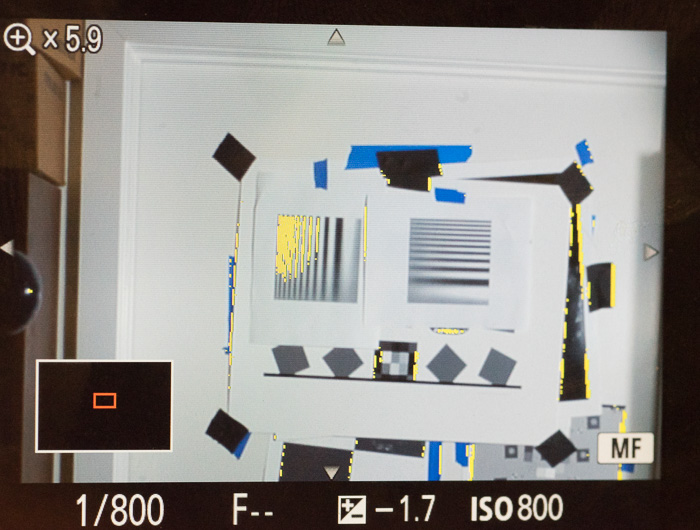It has seemed to me that the Sony alpha 7 camera line’s focus peaking is more sensitive to contrast variations in the horizontal than the vertical direction.
I thought to devise a test. I wrote a Matlab script to generate a sinusoidal grating that varied in one direction in frequency, and in the other direction in modulation index. I printed out two copies, and taped them to the wall, one in landscape orientation, and one in portrait.
Then I lit the target with a 5500 degree Kelvin flood, and pointed an a7II with a Leica 18mm f/3.8 Super Elmar lens on it at the two. I set the focus magnify to the lower magnification, turned focus peaking on, and this is what I saw in the LCD display:
You can see that the left grating, the one with the horizontal sinusoids, is lit up like a Christmas tree. The right grating, , the one with the vertical sinusoids, shows no peaking.
There’s one other thing you can see from this shot. Look at the left grating. The modulation index gets greater as you go higher on the chart. Note that the modulation required to trigger the peaking false color is a function of the frequency of the sinusoid, with lower frequencies requiring greater modulation. That is expected.
What is not expected is that the modulation required to trigger the false color rises at the very highest frequencies. I don’t think that is designed into the peaking algorithm. I think that it is a consequence of the lens’ resolution decreasing at those frequencies, and the subsampled display resolution also decreasing at those frequencies.
My guess is that the focus peaking is derived only from the digital equivalent of the horizontal scan lines, through an operation similar to differentiation and thresholding. It’s a quick, and definitely dirty, way to accomplish this function.
What’s this mean to a7x shooters? Angle your camera so that the greatest contrast changes are in the camera’s horizontal direction (when shooting in landscape format, look for vertical lines) to increase the focus peaking sensitivity. If you have a subject with more contrast changes in one direction than the other, you can get continuously variable focus peaking sensitivity — something otherwise unobtainable on the a7x — by rotating the camera to taste.
In case anyone has any use for it, here’s the code that generates the target:


I’ve noticed the same thing on the original A7. A local coffee house has a checker patterned carpeting where every other square has the carpet stitching going perpendicular every other square. Focus peaking only responds to the squares that appear vertical in the EVF.
Hi Jim, Well done and give me the opportunity to make the same test to my Samsung NX1!
And the result is equal. Only on vertical lines focus peaking works. Thus, I have to remember to rotate the camera to portrait orientation, when the image not have enough vertical lines for correct focus adjustment.